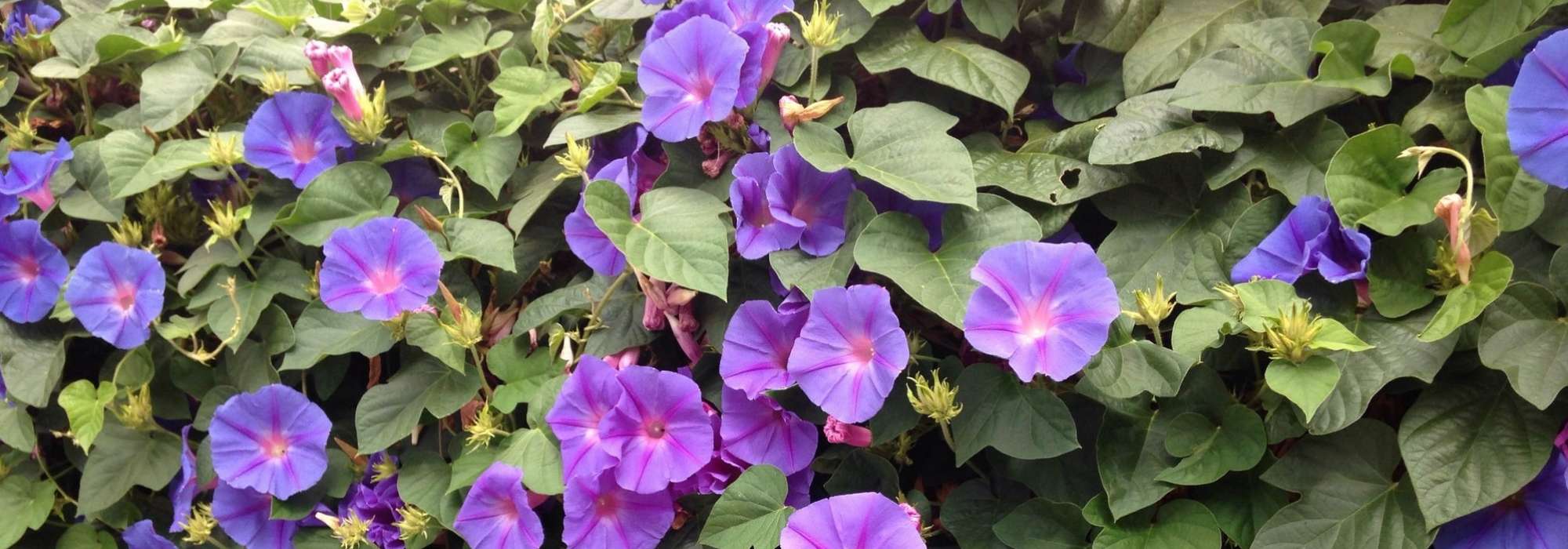
Ipomoeas: sowing, planting, growing and care
Contents
Ipomoeas in a nutshell
- Ipomoeas or volubilis are magnificent and vigorous climbing plants of tropical origin with spectacular flowering from July until the frosts
- The genus Ipomoea also includes sweet potatoes, valued for their admirable, colourful, and trailing foliage
- They are useful for concealing sheds, greening terraces and balconies, or decorating fences
- With the exception of Ipomoea learii (indica), they are not hardy in our climates and are grown as annuals
- In pots or in the ground, these beautiful exotics are very easy to cultivate
A word from our expert
Ipomoeas or morning glories, climbing lianas with large heart-shaped leaves, offer trumpet-shaped flowers in shades from white to azure blue, including red, throughout the summer. Ornamental sweet potatoes, the little sisters of morning glories, display opulent foliage in multiple colours that cascades languidly from pots and planters.
Their tropical origin makes them sensitive to cold, which is why most are grown as annuals in our climates, except for Ipomea learii which can return year after year if well protected during winter. Ipomoeas grow at a remarkable pace, literally engulfing their support with their lush foliage: from wire mesh to trellises installed on a south-facing wall, from planters to arbors! The exotic appearance of ipomoeas transforms your garden or terrace into a lush jungle.

Some ipomoea flowers: Ipomoea volubilis, Ipomoea ‘Crimson Rambler’, Ipomoea ‘Sunrise Serenade’, Ipomoea learii.
Ipomoeas are perfect plants for urban gardens. Indeed, the voluble and exuberant lianas allow for rapid greening of terraces and balconies, while freeing up ground space. The abundant foliage reduces urban heat reflection and the spectacular flowering attracts pollinators. Ornamental sweet potatoes also play their part: their long, flexible, trailing stems protect pot walls from direct sunlight, promoting coolness and thus limiting evaporation.
Description and Botany
Botanical data
- Latin name Ipomoea
- Family Convolvulaceae
- Common name morning glory (volubilis, glory of the morning - sweet potato)
- Flowering July to frost
- Height 3 m to 7 m
- Exposure sun
- Soil type moderately fertile and well-drained
- Hardiness from 10 °C to -8 °C depending on the variety
The genus Ipomea belongs to the family Convolvulaceae, just like our bindweeds, charming pests of our fields and hedges. However, unlike its relatives, the ipomées do not survive our winters, which eliminates their invasive nature and allows us to grow them peacefully in our gardens. The Ipomoea learii, also known as the Indian morning glory, is perennial and evergreen in mild climates. However, it can withstand short frosts of around -8°C if the stump is well protected. The Ipomea are predominantly herbaceous climbing and creeping plants, mostly originating from the tropical regions of the Americas. In our climate, they are grown as annuals or tender perennials. For the gardener, the ipomées include:
- lush climbers (known as volubilis, glory of the morning, blue bindweed…) generous flowering vines all summer long
- sweet potatoes (Ipomea batatas) used depending on the varieties, either for their highly decorative foliage, or in the vegetable garden for the production of delicious tubers
The broad, alternate leaves are cordate (heart-shaped) and borne on a long petiole. The flowers consist of 5 petals fused at the base to form a bell-shaped flower in blue, pink, white, or purple and are solitary, or grouped in threes or fives in small cymes. They open in the morning and close in the afternoon, at the height of the heat, and renew generously every 2 to 3 days. Sweet potatoes, whether ornamental or edible, flower much less (if at all), with interest lying in their beautiful foliage or the taste quality of their tubers.
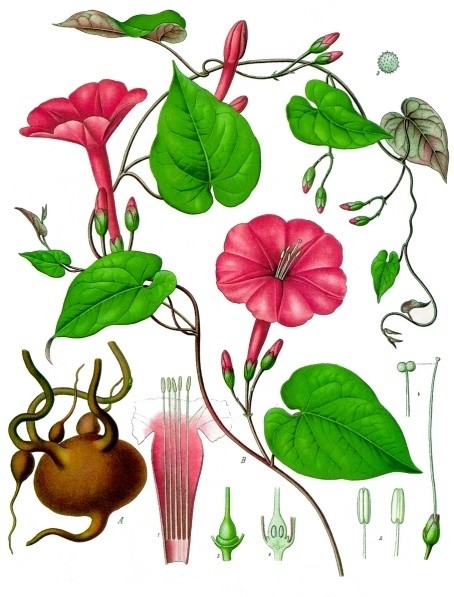
Ipomea purga – botanical illustration
Ipomées are superstars in Japan. The variety nil arrived in Japan 1000 years ago from China. It was then a medicinal plant (diuretic). After multiple cross-breeding, they became mythical plants, celebrated by poets, as they represent Ephemerality and Beauty. I. imperialis is one of those adored plants in the Land of the Rising Sun!
The uses of ipomées are numerous. Climbing varieties can form green screens, adorn a railing or fence, hide a wall, or create a flowering arch. Often blue, as seen in “Heavenly Blue“, their corollas can be striped with white, or tinted purple, like “Grandpa Ott“, or even proudly display a carnival of pink in the most audacious shades. In contrast, the variety “Cardinal Climber” produces scarlet red flowers on very finely divided and feathery foliage. Meanwhile, Mina lobata takes originality to present tubular flowers in incandescent colours!
We will choose sweet potatoes for their magnificent foliage that cascades out of their pot or from the top of a wall. They can also be used as ground cover. The range of colours expands year by year. The gardener can choose anise green to brighten up dark dahlias, or the Ipomée “Illusion Midnight Lace” with black foliage that can be paired with pink grasses or perennials with yellow foliage, or the coppery hue of “Sweet Caroline Bronze” to create vibrant pots or ground covers.
In addition to being beautiful, sweet potatoes are very useful for the gardener: their dense foliage naturally limits the growth of competitors and protects the soil from erosion. Moreover, they release a substance that inhibits germination: weeds are eliminated so that the ipomée can spread comfortably. This property of emitting natural herbicides or pesticides is called “allelopathy”.

Some decorative foliage of ornamental sweet potatoes: Ipomoea batatas ‘Illusion Midnight Lace’, Ipomoea batatas ‘Sweet Caroline Red’, Ipomoea batatas ‘Sweet Heart Dijon’, Ipomoea batatas ‘Sweet Caroline Light Green’.
The main varieties of ipomoeas
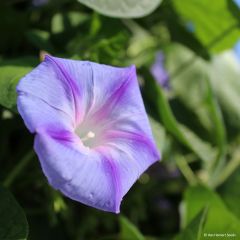
Ipomoea purpurea - Morning Glory Dacapo Light Blue Seeds
- Flowering time August to November
- Height at maturity 2 m

Ipomoea tricolor - Morning Glory Flying Saucers Seeds
- Flowering time August to November
- Height at maturity 2,50 m
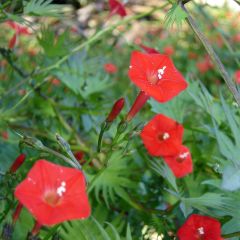
Graines d'Ipomée Cardinal Climber - Ipomoea x multifida
- Flowering time August to November
- Height at maturity 2 m

Ipomoea learii - Blue dawn flower
- Flowering time August to November
- Height at maturity 10 m
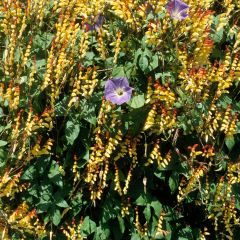
lobata Mina - seeds
- Flowering time August to November
- Height at maturity 2 m

Sweet Potato Jet Black - Ipomoea batatas
- Flowering time October
- Height at maturity 20 cm

Sweet Potato Sweet Caroline Bronze - Ipomoea batatas
- Flowering time February
- Height at maturity 70 cm
Discover other Ipomoea seeds
View all →Available in 1 sizes
Available in 1 sizes
Available in 1 sizes

Available in 1 sizes
Available in 1 sizes
Available in 1 sizes
Available in 1 sizes
Available in 1 sizes
Available in 1 sizes
Available in 1 sizes
Sowing and planting ipomoeas
Ipomoeas need warmth and humidity. Prefer a south-facing position, sheltered from the wind, and water them regularly, once or twice a week.
In pots, choose large containers as they grow quickly and abundantly. Opt for pots that are at least 30 cm in diameter or window boxes that are 60 to 70 cm long.
When and how to sow
You have two options for sowing: sow in March under cover or directly in the ground from late April to June. In both cases, soak the seeds overnight in water to soften the seed coat and facilitate germination.
For sowing under cover in March:
- Fill your pots with drainage holes at the bottom with special seed compost
- Moisten and firm the compost
- Make 1 hole with a stick the size of a pencil for each seed planted and place 3 or 4 seeds per pot
- Cover with a thin layer of compost and water
- Cover with a transparent lid (such as plastic wrap)
- Place in light, without direct sunlight
Keep the substrate moist but not waterlogged, and open the lid to ventilate at least once a day. When the seedlings emerge, cover only at night.
Plant in May at a distance of 40 cm in soil worked to three times the volume of your pot and enriched with compost or potting soil.
For direct sowing from April to June:
- Prepare your soil to a depth of 8 to 10 cm and about 20 cm wide by adding fertiliser
- Place the seeds in clusters (4-5 seeds in a hole at the depth of the seeds)
- Cover and lightly firm
- Water
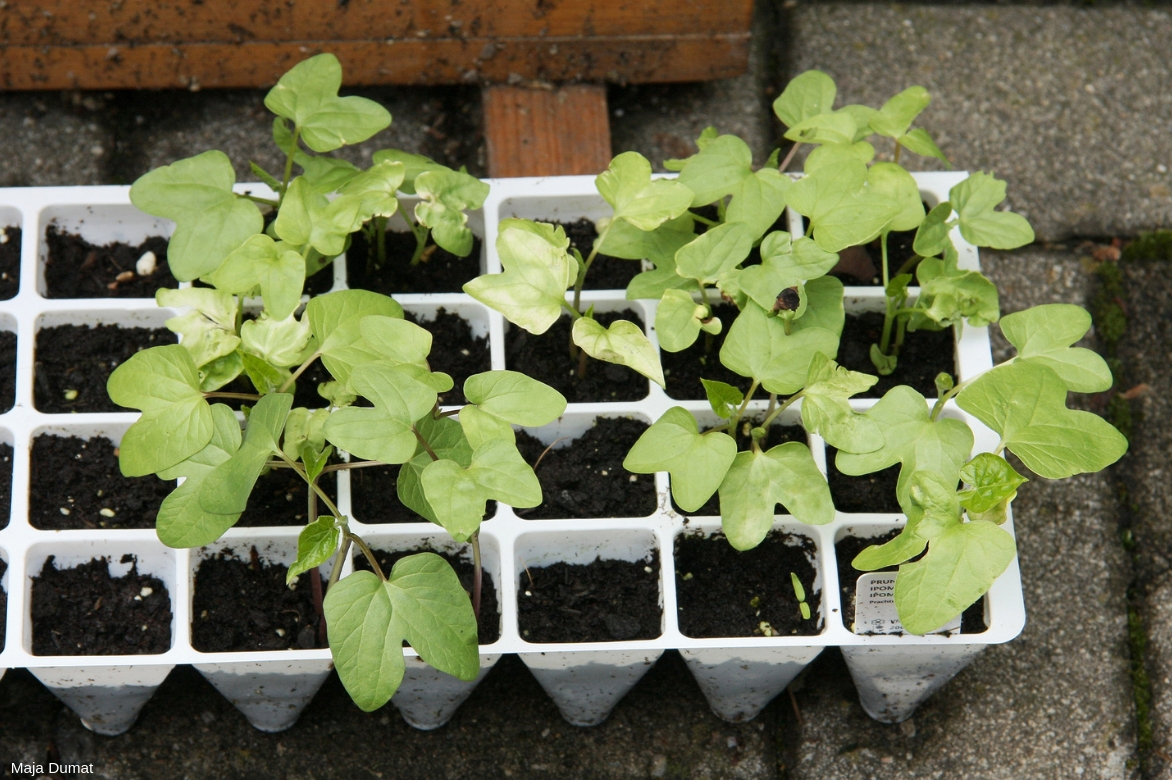
Sowing ipomoeas
If you are growing your ipomoeas in pots, the steps are the same, except for the first step:
- Choose a pot of at least 30 cm in diameter and ensure it has drainage holes
- Add a layer of gravel or clay balls for drainage
- Then fill the pot with special flowering plant compost
- Sow in clusters
To learn everything about sowing annual seeds, discover our advice sheet: “Sowing annual seeds: how to do it successfully, in the ground or in trays”
When and how to plant plug plants
Plug plants are available in March, but cannot be planted directly outside before the Ice Saints, or they risk freezing!
Here’s how to proceed upon receipt:
- Transplant the plants into a pot or plug (filled with flowering plant compost)
- Water without over-saturating
- Store under cover: conservatory, greenhouse, cold frame, at a minimum temperature of 14°C
- In mid-May, plant in the ground or transplant into pots for outside
You will find all the details for creating a window box with annuals on this advice sheet.
Caring for Ipomoeas
Pinch back the invasive stems to contain and ramify the vegetation. To prolong the flowering, regularly remove the faded flowers from the climbing plants. You can add flowering plant fertiliser every month to stimulate flowering.
Cut back to the ground at the end of autumn. For perennial varieties in mild climates, protect the stump with a good layer of mulch made of about 20 cm of fallen leaves. Be aware that the seeds of some varieties survive mild winters and can germinate as soon as spring arrives (notably I. tricolor and I. indica). You can either collect these new seedlings or pull them out if you do not want to be overrun. In colder areas, perennials can be brought indoors to a frost-free, cool, and airy place.
If you want to keep your sweet potato, simply lift the tubercle at the beginning of autumn and store it in dry turf in a frost-free, cool, and airy location.
Learn more at: Invasive Ipomoea: how to control it?
Diseases and Pests
Aphids can be attracted to the tender stems of ipomoeas. To prevent these attacks, create a balanced ecosystem in your garden: beneficial insects will feast on the excess aphids provided they have a welcoming environment. Offer nesting boxes for blue tits, insect hotels for hoverflies and ladybirds, and a mix of wild and cultivated flora for biodiversity… However, if the invasion is too severe, spraying diluted black soap in water can be an effective solution.
Red spider mites can be a formidable enemy during hot weather. To get rid of them, water the foliage as these little pests dislike humidity.
Despite their tropical origins, ipomoeas have managed to withstand the diseases of our regions.
Multiplication
In nature, ipomoeas propagate either by their seeds, or by layering using their stems that are brought to crawl on the ground, or even by their tubercles.
By collecting the seeds from the flowers you have allowed to mature, you will obtain more climbing plants by sowing them the following spring. The flowering of these new plants will often be different from that of the parent plant.
Sweet potatoes rarely flower, which is why propagation by cuttings is practiced.
Here is a method for propagating sweet potatoes by cuttings:
- At the end of winter, place the tubercles from the previous year in a pot of potting soil and keep moist until shoots germinate
- Take sections of stems with 3 to 4 eyes
- Plant in the garden 40 cm apart in all directions or in a pot with a minimum diameter of 30 cm
- Water and mulch to keep moist and warm
Associations
Climbing sweet potatoes or volubilis, with their lush foliage, bring an exotic touch to a corner of the garden or terrace for summer. They can naturally blend into this jungle garden.
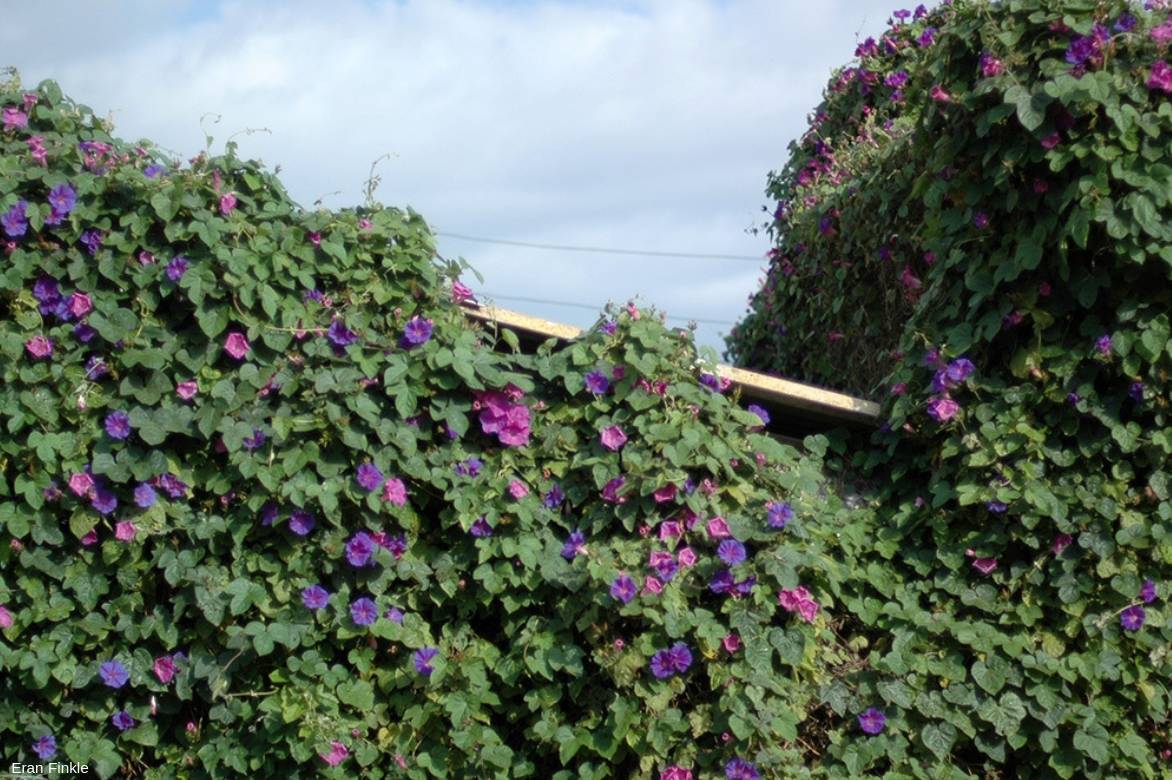
Ipomoea volubilis can quickly colonise an unsightly structure.
The base of a dark purple flowered ipomoea will be delicately illuminated by the orange-pink daylily “Mini Pearl” and the fluffy coneflower “Coupe Soleil”. The hardy geranium “Blue Sunrise” will complete the ensemble with the ultramarine blue of its flowers, enhanced by the golden yellow of its foliage.

An example of association: Ipomoea batatas ‘Sweet Heart Jet Black’, Ipomoea ‘Sweet Caroline Red’ (a variety close to ‘Sweet Caroline Bronze’), Anisodontea ‘Lady in Pink’, Petunia ‘Raspberry Star’, Pennisetum ‘Vertigo’.
The chartreuse sweet potato paired with a knotweed “Purple Fantasy” and golden stipas will joyfully animate a corner of the garden. Martagon lily ‘Claude Schride’ dotted throughout will surprise in June and July with its burgundy red turban flowers.
Did you know?
The trumpet shape of flowers enhances pollination. Indeed, the tube forces the nectar consumer to enter the flower to reach its centre, passing through the stamens and the stigma. The insect collects pollen and disseminates it to other flowers. This optimises pollination with a limited amount of pollen and a reduced number of stamens.
There is a fun (and anecdotal!) detail about the morning glories: the soft, villous stems wrap around their support from right to left while, in their bud, the petals of the flowers are rolled in the opposite direction!
To combat adventive plants in organic sugarcane production, some authors recommend placing rows of sweet potatoes between the rows of sugarcane as they have allelopathic properties.
Useful resources
Discover our varieties of morning glories, not forgetting the young plants of sweet potatoes for the vegetable garden!
For a feast for the eyes, admire the national collection of Ipomea of Japan managed by Kyushu University. There, the climbing plants are called “asagago” or morning face.
Frequently asked questions
-
I sowed an ipomoea this spring and it has grown well, but it isn't flowering! What can I do to see it bloom?
These climbing plants with rapid growth are very greedy: with the watering water, add a special flower fertiliser, low in nitrogen (symbol N), once a month. Don't hesitate to pinch the new stems to encourage them to ramify, as this promotes flowering.
- Subscribe!
- Contents
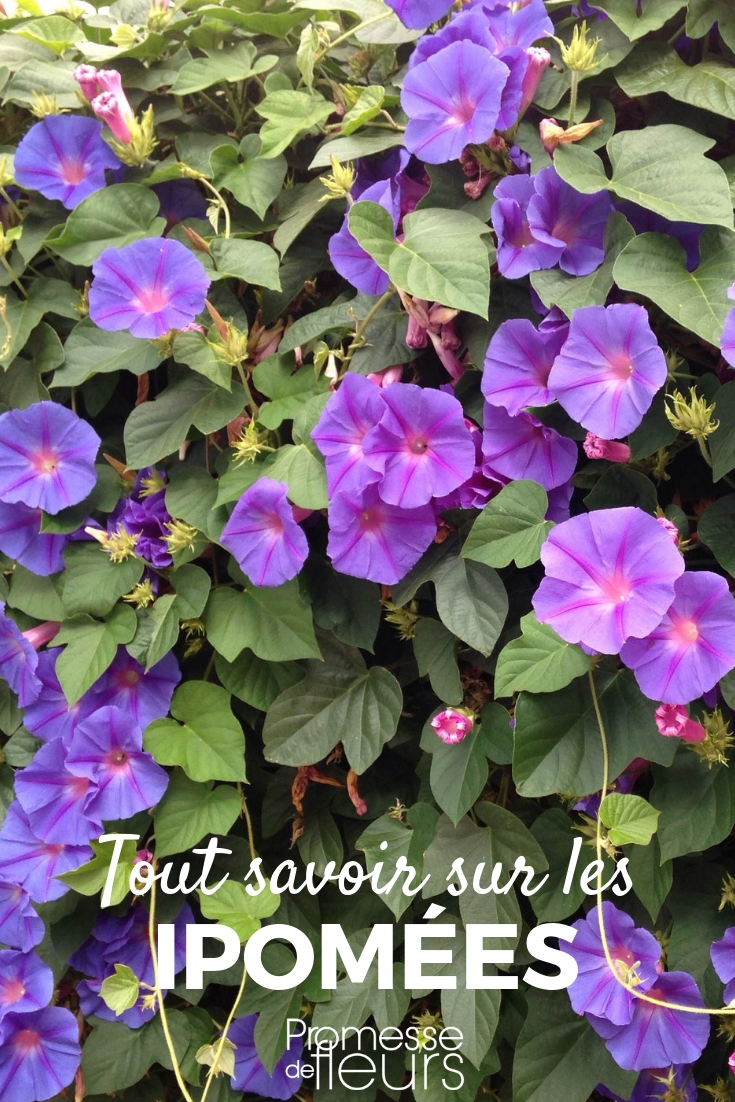
































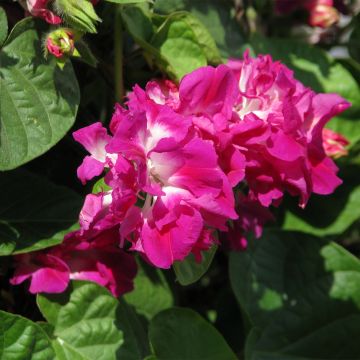



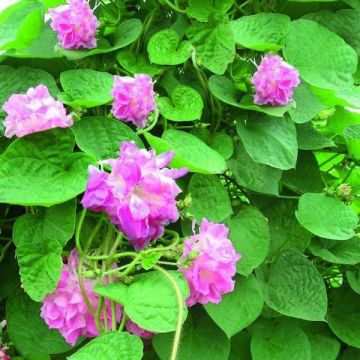
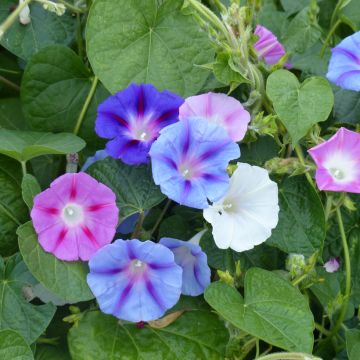


Comments